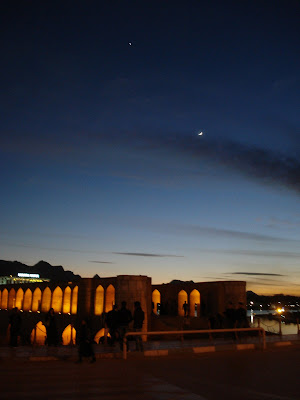Just Fallen Short
Quasi-periodicity in 15th century Islamic Art and whether it actually has been developed as a concept is still a matter of a somewhat controversial debate. There are three sites in the city of Esfahan which have been studied in this regard in considerable detail, two rather small patterns on a spandrel and a portal on the Darb-i Imam shrine in the Dardasht quarter of the old city (1453) and a huge pattern on the western iwan of the Great Mosque. Several authors have, in the meantime, tried to overlie Penrose patterns of kites and darts or thick and thin rhombuses in order to prove that medieval artisans were able to apply what had been described by Roger Penrose only five centuries later. See, for example, Lu and Steinhardt (2007), their response to some additional work by Makovicky (2007), or Cromwell (2008) here, here, and here.
However, while a certain desire for subdivision and self-similarity can easily be traced on the respective buildings, it is not perfect, in particular not at the Darb-i Imam’s spandrel and portal, and the Great Mosque’s western iwan (probably 17th century). The higher level of girih- or proto-tiles is composed of decagons and bowties in each case only. I have pointed some time ago to a possible solution for creating in fact a perfect subdivision if one had considered a special arrangement of girihs in the upper right corner of the spandrel of the Darb-i Imam, which is composed of decagons, bowties and, in fact, the elongated hexagon, or bobbin, which can be found all-over. The picture below indicates the higher level pattern originally found on the spandrel (left) and a suggested pattern (right) which takes into account a small portion of the lower level pattern in the upper right corner. See more information here.
On the western iwan of Esfahan’s Great, or Friday, Mosque, the highest level is composed of alternating half decagons while the spaces in-between are filled with half bowties. Both decagons and bowties follow mainly the suggested subdivision rule. However, the pattern is distinct as it introduces, at the intermediate level, a rhombus, which is otherwise missing in the subdivision. If one adds colors (picture below, left), it becomes clear that the artisans just fell short in creating a true Penrose pattern.
The picture below shows the western iwan, or sofe-shāgird, the iwan of the student (sic!). Sofe-e ustadh (the iwan of the master) faces it, it is the eastern iwan.
That medieval artisans just fell short of creating something that would really have amazed us 500 years later may be regarded as indirect proof that they had not really penetrated the mathematical concept. But if they actually had, why would that have been more interesting? Medieval artisans were keen to produce, with the help of eminent mathematicians, interesting ornaments and designs on mosques and buildings, not mathematical breakthroughs. They achieved a ‘dazzling’ appearance anyway; I have pointed to that several times here on this blog, see here and here. By removing color as a common element, for instance in the case of the Gonbad-e Qabud in Maraghah (1196), they even created something what would absorb and dazzle scientists even eight centuries later.
That has made a lasting impact, hasn’t it?
First published at Freelance.






Comments